In 1994, a 24-year-old Tim League, then an engineer at Shell Oil in Bakersfield, California, was driving to work when he noticed the words “For Lease” on the marquee of the Tejon Theatre, a cinema dating back to the 1940s that had fallen on hard times. Unhappy with his original career choice, League was fixated on the idea of opening his own movie theater. He spent the rest of that week researching the exhibition business—driving to Los Angeles to pick up a copy of Boxoffice Pro magazine as a reference—and putting together a rough business plan. Within a week, Tim League had signed the lease on his first cinema.
League ran that movie theater in California as an art house, side by side with his girlfriend, Karrie, who quit her job to manage its operations. The cinema only lasted two years. By that time, Tim and Karrie had gotten married and were determined to find a way to realize their dream as exhibitors in a new market where they could build on their experience in Bakersfield. The couple moved into Karrie’s parents’ house for six months to analyze opportunities, eventually settling on Austin, Texas, as their next destination.
“We didn’t know anything about the exhibition industry when we started,” says Tim League. “The location in Bakersfield wasn’t the right spot. It was a depressed part of town with a high crime rate. I didn’t go to business school and had leaped forward without knowing that all-important mantra: The three most important things about business are location, location, location, and we failed on all three. When we arrived in Austin, securing the right location became the most important thing.”
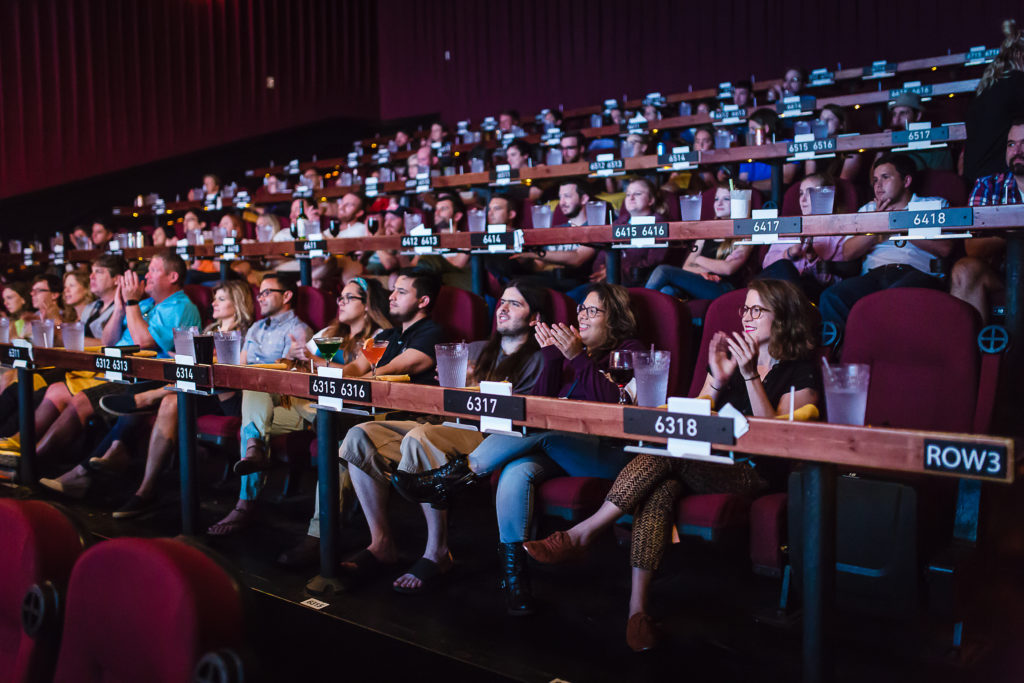
A big university town with a vibrant film scene, the Texas capital was a center of 1990s counterculture. Filmmaker Richard Linklater, the founder of the Austin Film Society, had helped establish a grassroots cinephile community in Austin. It was an ideal site to launch a new theater … if they could secure a lease and the capital to open it.
The Leagues’ entrepreneurial enthusiasm was met with a wave of rejections as they attempted to find a spot in one of the city’s burgeoning entertainment districts. Austin was undergoing a transformative real estate boom in the late 1990s; landlords weren’t looking to lease space to a mom-and-pop movie theater without a proven track record. Eventually, they found space in what Tim calls “the second floor of a parking garage, basically an unrentable space,” but in a part of town they believed could work in the long run. The Leagues scraped together as much money as they could, taking on loans from their parents, and remodeling the space themselves over the next six months.
In 1997, Alamo Drafthouse’s first location opened on 409 Colorado Street in Austin, Texas—a one-screen, second-run site selling discounted tickets. “This one had to work because, in terms of burn rate, we could operate for about a month and a half, two months tops, before we’d be out of business,” remembers Tim. “Luckily, three weeks in, we got a nice article in the Austin American-Statesman, and the very next weekend the theater was packed. It was off to the races from there.”
The early years at Alamo Drafthouse were marked by a strong feeling of community with the Austin film scene. “Having Alamo Drafthouse [in Austin] was revitalizing,” says Lars Nilsen, who currently serves as the lead programmer of the Austin Film Society and was a part of the Alamo team in Austin between 2001 and 2013. “In hindsight, what Alamo did was to use the resources of the art house film scene and apply them to a more popular cinema model. We sought to use the grassroots messaging and language of art house cinema and apply it to films we saw in our youth. Tim League was one of the first people I met who said, ‘We’re not going to spend money on newspaper ads anymore because it doesn’t matter.’ The whole idea was to put everything into guerilla marketing and eventize everything we did to build word of mouth.”
It may not seem revolutionary to today’s audiences, but in the late ’90s newspaper advertising was a principal marketing tool for cinemas. Ads in local papers were the most common ways for the moviegoing public to get their showtimes. According to Tim League, Alamo Drafthouse stopped running ads in local papers around a year after opening. “We’ve always been big on gathering data from our guests. We polled everybody that was on our email list at the time—we were leaning heavily into internet marketing, which was pretty new at the time,” he says. “I think maybe 6 or 7 percent of our guests were getting their showtimes from the newspaper—so we just shut it down. Newspaper advertising was expensive; you had to run ads every single day. It made more sense for us to sacrifice that 6 or 7 percent of traffic and spend the money elsewhere. Our idea has always been to let people know who we are by putting on events so outrageous and fun, that they will organically talk and write about us. That’s always been our learning, and it’s part of who we are up to this day.”
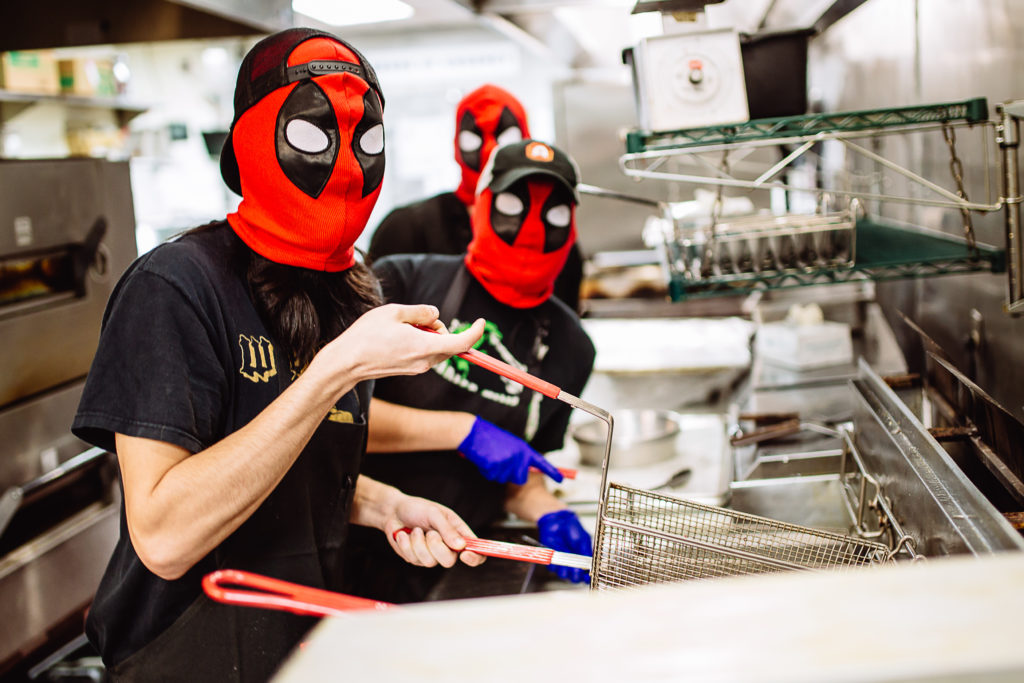
Alamo Drafthouse continues to be an early adopter of digital marketing efforts. League says that culture has played an important role in establishing both brand loyalty and recognition. Alamo has invested heavily in its website and mobile apps and was one of the first movie theaters to offer digital ticketing in the United States. “We’ve always been technology-forward, and it has allowed us to build a tech team that can compete with bigger circuits,” he says. “We beat everybody with online ticketing. Years later, when MoviePass came out, instead of yelling ‘‘The sky is falling!’ we spent six to eight months building our own subscription service. The technology in itself isn’t the main factor, but how we use our voice through that technology to build a direct relationship and line of communication with our guests.”
Alamo Drafthouse began gaining national attention outside Austin because of the way it eventized the moviegoing experience. In 1999, the theater launched a nine-day film festival hosted by Quentin Tarantino—an early evangelist of the Alamo Drafthouse model. Other events, like that year’s Cannibal Film Festival, which marketed “human flesh on the screen and on your plate,” drew the type of attention that prompted a visit from the health department to inspect the kitchen, due to concerns of actual cannibalism.
Cannibalism gags aside, Alamo’s attention to the dine-in element of its identity began around that time. In fact, the Leagues’ first theater in Bakersfield had experimented with dinner-and-a-movie nights—The Bicycle Thief paired with dinner catered by an Italian restaurant, for example—and they had come to Austin ready to expand on the concept. During their honeymoon, which Tim describes as “a working honeymoon,” the couple stopped by the cinema-pub McMenamins, in Portland, Oregon, and drew inspiration from the model ahead of opening the first Alamo in Austin. The Leagues tweaked the dine-in concept in a unique way to fit their new cinema, even if their combined experience in the food service sector consisted of stints waiting tables and working at a pizza restaurant.
Like any business, the Alamo Drafthouse encountered new challenges once it decided to expand beyond a single location. The second site, Alamo Drafthouse Village, opened in Austin in 2001, adding a second set of screens—and a second kitchen—to the burgeoning cinema chain. Tim League lists the opening of that second location as one of the company’s biggest milestones. “We had to buy a second car,” he remembers. “We had to learn how to develop our team, develop managers. We were hands-on, but our training in the first five years was awful. We kind of threw people to the wolves; those that couldn’t grab it left, and then those that could grab it scratched their way to a level of understanding—and that’s not right. When the opportunity came to expand further by franchising, we saw it as a way to structure the growth of the company—where you can’t fly by the seat of your pants, where you have to invest in training. The company gained a different level of maturity by taking that step.”
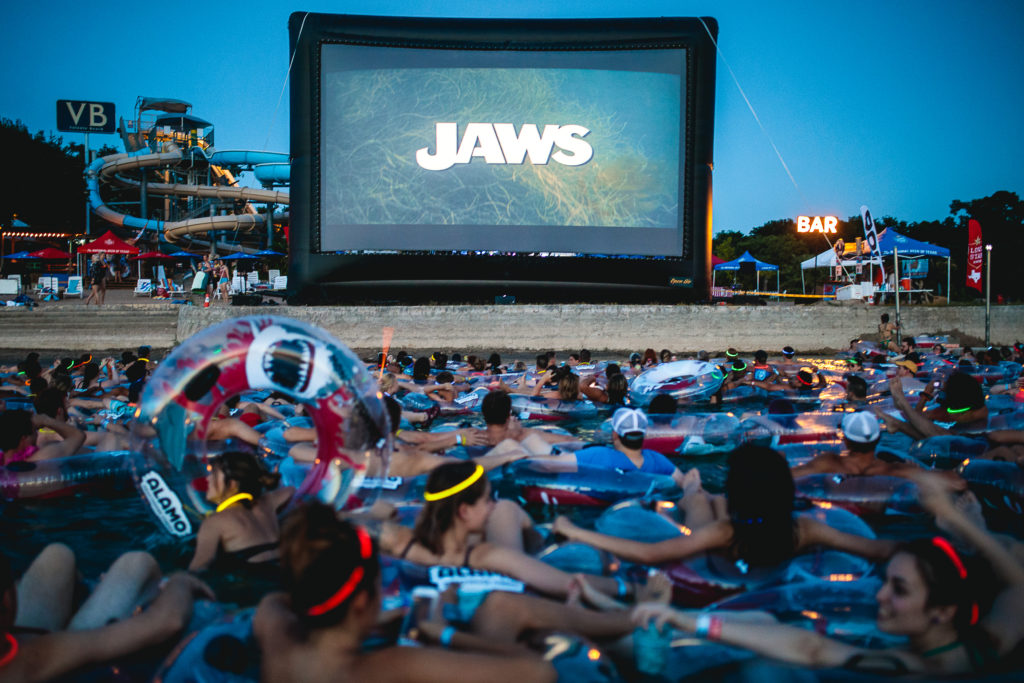
The Leagues accepted an offer to implement a franchise model in 2004, whereby ownership would be split between the Leagues, who retained control of the Austin locations, and franchisees. This created two different Alamo Drafthouse experiences—with different websites, menus, and management groups running their respective sides of the company. “By 2004, Karrie and I were having a hard time coming to grips with growth and moving beyond the Austin market,” he says. “That’s really why we split [the company], leaving Karrie and me to run the Austin locations. During that time, we focused our efforts on developing and defining the identity of the brand.” During that period, the Leagues launched projects like the Mondo movie-themed merchandise brand, in 2004, and Fantastic Fest, a genre film festival, in 2005.
As the Alamo Drafthouse embraced expansion, it was also forced to streamline its kitchen operations to provide a consistent dining experience. Trish Eichelberg, who currently serves as the circuit’s director of food & beverage, first joined Alamo Drafthouse in 2005—amid that expansion—as an assistant kitchen manager in Austin. “I was brought on from a fine-dining restaurant in Austin that Tim and Karrie frequented. They liked eating there, and they hired some of us to elevate the menu at the four locations they were overseeing at the time,” she says. “The menu looked very different back then. There were a lot more convenience foods, things you could just throw into an oxy fryer, and our job was to transition to items we could cook and serve.” That transition began with the opening of the Leagues’ South Lamar location in Austin, their biggest site to date. The Alamo Drafthouse began operating more formally as a restaurant kitchen: marinating chicken and mixing salad dressings in-house instead of serving them from store-bought bottles.
Alamo Drafthouse continued to expand, operating as two different circuits under the same brand from 2004 until, over the course of what Tim League calls “a fateful pancake breakfast” in 2010, he was named CEO of the combined circuit. “Once we merged everything, that’s when we got into growth mode, seized some opportunities, and started growing more quickly,” he says. By that point, many of the Alamo’s trademarks had already been introduced—its unique pre-show comprised of archival footage oddities, eclectic programming series with deep-cut genre treasures, and a strict no-talking, no-interruptions policy. League credits the no-interruptions policy to a raucous screening of David Lynch’s Blue Velvet, where cases of Pabst Blue Ribbon were sold at a deep discount. The atmosphere was so unruly that League decided to institute the policy the very next day. It didn’t take long before he had to enforce the policy personally—after a screening, in Austin, at which he reprimanded a patron, the disgruntled moviegoer began shouting at him. He was sure the guy was about to throw a punch, until another audience member tapped the yelling man on the shoulder. That second patron was none other than Quentin Tarantino, who came to League’s defense and prevented any escalation—or so the legend goes.
“Tim didn’t like the way people were clowning around and talking over a movie; that was the origin of it,” says Laird Jimenez, who currently leads the team producing Alamo’s public service announcement (PSA) snipes. “The PSAs started as funny found-footage clips that we could use to explain the policy. Now we have celebrities and studios wanting to provide us with custom-made videos. It’s a balancing act, because we don’t want to be unwelcoming. Some people are turned off by how strict we make it seem, but we just want everybody to have a good time. If you can’t watch a movie without ruining the experience for 20 other people, then you’re doing it wrong. We feel like the best way to get that message across is with humor, because none of us takes this stuff that seriously.”
The PSAs are part of Alamo’s pre-show—the circuit eschews cinema advertising—and early versions were produced on VHS tapes, with programmers like Lars Nielsen and Tommy Swenson editing together archival clips that had been unearthed by a community of found-footage aficionados. The pre-shows remain a staple of the Alamo Drafthouse experience, and many still include vintage exhibition snipes and found-footage oddities. Some are more serious-minded. Earlier this year, for example, Alamo Drafthouse included a video essay by Ray Loyd, creative director of the Austin Asian American Film Festival, telling the history of Asian American representation on-screen during its pre-show for Everything, Everywhere, All at Once. “That’s an example of edutainment at a level we hadn’t done before; it took our pre-show to a new place,” says Jimenez. “There are certain movies where it would be inappropriate to have a pre-show that comes off as too silly.”
Alamo Drafthouse’s programming is as eclectic as its pre-shows. Sitting somewhere between an art house and a commercial multiplex, the circuit programs everything from specialty titles to repertory selections to the latest offerings from Hollywood’s major studios. One of the circuit’s biggest strengths against its competitors is its robust repertory programming series on off-peak nights. That’s when its programmers host esoteric gems from a variety of diverse genres to drive traffic during otherwise quiet days of the week. “The origin of everything is fandom,” says Jimenez. “Tim League loves genre movies and wanted an excuse to get together on Wednesday nights to show these prints he had. That is how our Weird Wednesday and Terror Tuesday series started. You can go see a Marvel movie at any theater on a Wednesday night, which is usually slow for business anyway, so what can Alamo offer that’s different? Since we have a programming staff, we can play a range of things—from a sure hit that even an algorithm could pick, like The Goonies, to deep cuts. Earlier this summer, I programmed a 1987 Hong Kong movie on 35 mm, and we had a three-quarters-full theater. It outperformed Top Gun: Maverick in the same slot. The audience is there, you just have to build it. It’s not something that happens overnight.”
As the years, passed Alamo’s curatorial approach to programming expanded to reach more diverse audience segments. Sarah Pitre first joined Alamo Drafthouse as a programmer in 2008. “My boyfriend at the time—who is now my husband—had been working there since the early years. One day he came over to my apartment and was looking through all my DVDs—mostly romantic comedies and other female-focused films—and asked me how often I watched those movies. I was like, “All the time!” Alamo wasn’t showing those films back then; there was a big blind spot in terms of programming. So he talked to Tim and they invited me to come in and program a series on female-driven titles.”
Pitre launched that series, initially called Girlie Night and retitled Champagne Cinema in 2008. The series claimed a spot on Tuesday nights at Alamo’s Ritz location in downtown Austin, with shows letting out just as the Terror Tuesday horror screenings would begin seating. “I remember standing in the lobby and seeing the most opposite audiences cross paths,” she says. “We had a lot of women and gay men attending. They’d flood out of the auditorium giddy on the movie and champagne just as all these dudes in black T-shirts made their way into Terror Tuesday. Those ships passing in the night, that mix of people in the lobby, that’s Alamo Drafthouse. That is what we do. We’re a home for those women who love romantic comedies and those dudes who love their cult horror movies. Those Tuesday nights are the greatest illustration of what Alamo Drafthouse excels in: celebrating all kinds of different films and different audiences.”
Today, Pitre acts as the circuit’s head film buyer, one of the most important executive roles at any cinema chain. She says her early days as an Austin-based programmer was the ideal training ground for the role. “We weren’t yet at the phase where we had to do national programming,” she remembers. “We were a small team that had a lot of freedom to focus on Austin and connect with our local audience. It taught me how to listen to audiences and serve particular demographics in an area. Those are lessons I took with me over the years, as we went from programming three theaters in Austin to 36 across the country. We want to be the home for movie fans of all kinds. It’s less about genres and more focused on celebrating cinema in general. No matter what kind of movie you’re a fan of, we want you to have the best experience at the Alamo. That’s what has informed our expansion in programming as we’ve expanded as a circuit.”
Alamo ramped up its expansion efforts once the company was united under Tim League in 2010. That growth coincided with a national dine-in cinema boom, as competing circuits specializing in the concept—players like Studio Movie Grill, Movie Tavern, and Ipic—began pursuing a similar strategy. John Smith, who joined Alamo Drafthouse in 2013 and currently serves as senior film programmer, says that the difficulty of executing the dine-in model was one of the main challenges of going from a local cinema to a national chain. “The things you have to think about and plan for are so much more complicated when you add food and alcohol,” he says. “At a normal theater, you can put up a gymnasium-sized building, buy some projectors, add a concession stand in the middle—and you’re good to go. With [dine-in], you also have to account for a full working kitchen that can support the same number of people as an Olive Garden. Then you’ve got to be able to structure your showtimes so that you’re not showing three or four sold-out shows simultaneously, otherwise, you get 400 to 500 people trying to order a burger at the same time. Over time, we developed a better sense of how to execute this concept in the right markets.”
As Alamo went national, so did its menu. Trish Eichelberg recalls learning about the public’s regional tastes as the circuit added sites in different parts of the country. The pizza sauce, for example, proved too spicy for diners in Yonkers, New York. In Brooklyn, the F&B team was initially too intimidated to include pizza on the menu. They only introduced it after realizing pizza was prevalent everywhere else in Brooklyn and their own recipe could hold its own. Before the supply chain disruption caused by the pandemic in 2020, Alamo Drafthouse built its menus around a philosophy of 70 percent core items and 30 percent local fare from area vendors. This allowed the flexibility to craft food and alcohol menus to suit local tastes.
Nationally, some of the chain’s best-selling national menu items over-index in certain markets. In San Francisco, which League has called the circuit’s most difficult location to open, sales of Alamo’s Chips & Queso—a stalwart appetizer in Austin—is known to outperform popcorn on occasion. Other iconic dishes, like its Buffalo Cauliflower, emerged as a result of special limited-time menus. “We originally put our Buffalo Cauliflower in a separate section of the menu; it was kind of relegated. We had it there so our vegan customers could feel a little indulgent, too. Now it’s one of our top sellers,” she says.
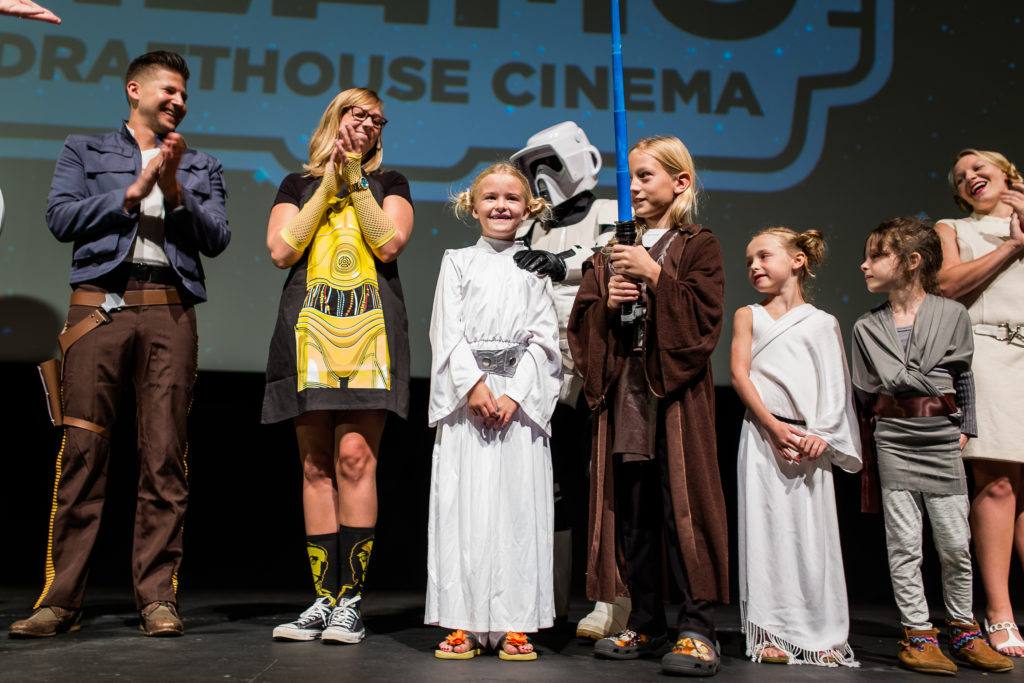
League cites the opening of Alamo’s Los Angeles (2019) and New York locations (Brooklyn in 2016, lower Manhattan in 2021) as another important milestone in the company’s history. “It increased the visibility of what we can do. There are a lot of independent films that rely on New York/L.A. openings. A lot of our growth has been opportunistic, but moving into L.A. and New York was by design, to have more of an influence in exhibition,” he says.
Those theaters offer insight into the future of Alamo Drafthouse’s new builds: more screens and smaller auditoriums to better accommodate more diversity in programming. “Lower Manhattan was specifically designed to have a lot of small auditoriums. That way we could accommodate the Pixar’s of the world, but we could also play the latest from IFC, Variance, or other smaller distributors,” says Sarah Pitre. “To me, our lower Manhattan and downtown L.A. locations are my dream theaters because you have a lot more freedom to program, even though the auditoriums are smaller. That’s how, in our L.A. theater, for example, we can sell out Top Gun: Maverick and a movie like Gaspar Noé’s Vortex in the same evening.”
Alamo Drafthouse’s evolution from a community movie theater to one of the country’s 20 largest cinema circuits has come with its share of operational crises. In the years preceding the pandemic, the company faced criticism from former employees claiming it minimized reports of sexual harassment and that several locations fostered a hostile work environment. Allegations of workplace misconduct continued into 2020, and the organization was soon struggling to cope with another crisis—the disruption of the Covid-19 pandemic. Tim League stepped down as CEO in April of that year. A large portion of its staff was let go in the ensuing months as the chain downsized on the heels of the pandemic’s cinema closures.
“It was one of the hardest moments I’ve had, looking in the mirror and deciding that maybe I’m not the perfect CEO for the company,” says League, who now acts as Alamo Drafthouse’s executive chairman. “I think I have a lot to offer and will always have a lot to offer. I find myself drawn to the marketing and events, the branding, the design, and the look and feel of the theater. But I was never terribly good at operations. In the early days, I would be in the booth running projection, and while I was up there, I would do all the marketing, design, and anything on the technology side. Karrie would run the business and handle the team, she did H.R., payroll, and finance. She steadily replaced herself with exceptional people, with stronger abilities than her own. Moving forward, as we grow, I like being on the brand-positioning side of things. Building a world-class operations engine and training organization has not been one of my strengths.”
In its darkest hour, Alamo Drafthouse turned to veteran executive Shelli Copelan Taylor to take the reins as CEO. Having prior experience at companies like Starbucks and Planet Fitness, she entered the role with the knowledge and experience Alamo Drafthouse needed to excel and expand on the national stage. “Growth and change are always grounded in our purpose to be the best damn cinema that has or ever will exist. And change only happens through incredible individuals who come together as a team,” she says. “We do not think about change as much as we think about the voices and input of our stakeholders—from teammates, guests, franchisees, studios, industry partners, and investors—in how we are striving to achieve our purpose. Over the past two years, we have doubled down on efforts to support and build our internal team, to simplify what we do in pursuit of creating the chemistry that can only happen in a movie theater when an incredible film and audience come together for the ultimate community experience.”
Alamo Drafthouse filed for Chapter 11 bankruptcy protection in March 2021, emerging three months later with a new ownership group and plans to expand to additional U.S. markets. Taylor has spent time making sure that the circuit’s corporate culture can recuperate from its recent turmoil. She has instituted workplace resolution resources in individual locations and established a one-stop helpline for staff. “We have made or are making progress in communication, health care, and wages,” she says. “We have increased communication and transparency throughout the organization in both formal and informal methods. We have increased hourly pay from 25 to 40 percent, depending on the market, and we are expanding our health care program to be more accessible to more teammates, particularly our theater teammates.”
New executive hires, like the appointment of exhibition veteran Heather Morgan—with executive experience at top-10 circuits like AMC and Harkins Theatres—as Alamo’s chief of staff and strategy, bolster the chain’s credentials as one of the country’s leading circuits and its ambitions to grow in the coming years. Alamo Drafthouse is scheduled to expand its presence in existing markets with new sites on Staten Island (its fourth in New York), a second Washington, D.C., location, Grand Prairie (the fifth in the Dallas–Fort Worth area), and Glendale, Colorado (the fourth site in the Denver area). The circuit will also be entering new markets in the coming years, including St. Louis, Chicago, Birmingham, and Boston—with an additional city expected to be announced this fall.
Alamo Drafthouse has refocused its efforts on exhibition in recent years. Ancillary properties, like the movie-focused website Birth.Movies.Death, specialty distributor Drafthouse Films, and the movie merchandise brand Mondo, have been sold since the onset of the pandemic. Drafthouse Films launched in 2010 with its first title, the British dark comedy Four Lions, and continued contributing festival acquisitions to U.S. theaters until League stepped away to co-found Neon in 2017. Alamo sold Drafthouse Films to Giant Pictures in March of this year. Mondo, which began as an iron-on T-shirt side gig run out of a former Alamo ticket booth, was sold to the pop culture collectibles brand Funko in June.
One part of the business that Alamo Drafthouse has no plans of parting with is Fantastic Fest, the annual genre film festival held in Austin, which Tim League calls “integral” to the company’s wider efforts in promoting film culture. All in all, the strategy seems to be paying off. Taylor says that Alamo Drafthouse is quickly closing in on 2019 revenues, and several locations are outperforming 2019 results “and all expectations.”
“Every day we are pushing to increase the diversity and breadth of titles that we celebrate with our audiences,” she says. “We are innovating against the physical experience in the areas of projection, sound, line of sight, and seating for every guest. We are working to remove all distractions during the movie while continuing to serve the best scratch food and beer available. We will continue to expand unique Alamo events such as Fantastic Fest, Rolling Roadshow, movie parties, talent Q&A, and so much more. And most importantly, we will continue to build a culture and team of movie lovers for movie lovers—so that the passion that runs deep today, runs even deeper in the future.”

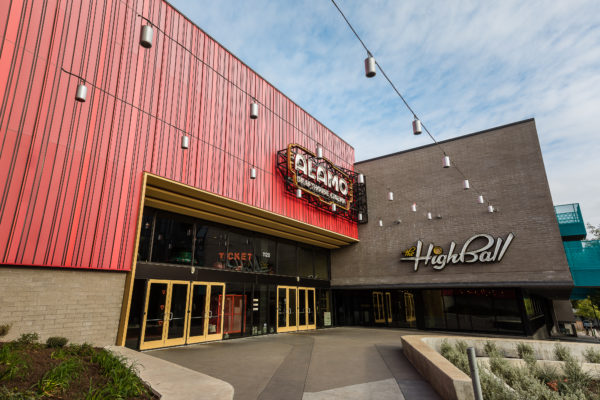

Share this post